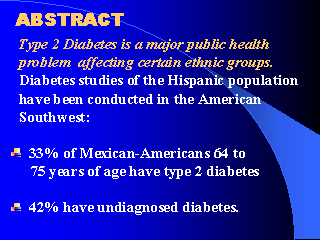|
|
|
|
front |1 |2 |3 |4 |5 |6 |7 |8 |9 |10 |11 |12 |13 |14 |15 |16 |17 |18 |19 |20 |21 |22 |23 |24 |25 |26 |27 |28 |29 |30 |31 |32 |33 |34 |review |
 |
There have been an extensive number of diabetes studies among the Hispanic and
Mexican-American populations in the American Southwest. Four prominent studies
and one based on Hispanic Health and Nutrition Examination Survey data will be
discussed.
According to the National Institute of Diabetes and Digestive and Kidney Diseases (NIDDK):
This lecture/presentation will examine the prevalence of Type 2 Diabetes Mellitus (Type 2 DM) and the dental public health ramifications among older people, particularly women, of Hispanic ancestry living along the Texas-Mexico border; a segment of a population at risk on which this particular aspect of Type 2 diabetes has not been completely addressed. The lecture presents the results of a survey, which suggest that there is a higher prevalence of Type 2 diabetes with 33 percent of Mexican Americans 64 to 75 years of age that have Type 2 diabetes and 42 percent with undiagnosed diabetes. The lecture also will provide an insight as to the magnitude of the impact of Type 2 diabetes on dental public health; the assumption is that Type 2 diabetes is a contributing factor rather than the primary etiological factor in the initiation of oral disease. This presentation will contribute further to the understanding of the oral manifestation patterns related to the high incidence and prevalence of Type 2 diabetes and the relative role played by different risk factors. The specific goal of the lecture is to examine the distribution and demonstrated-determinants of Type 2 Diabetes Mellitus in order to plan for future dental public health care and prevention programs. |